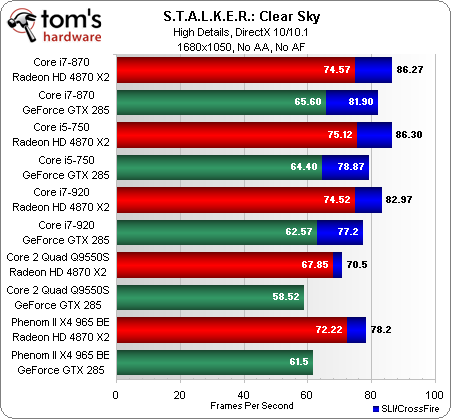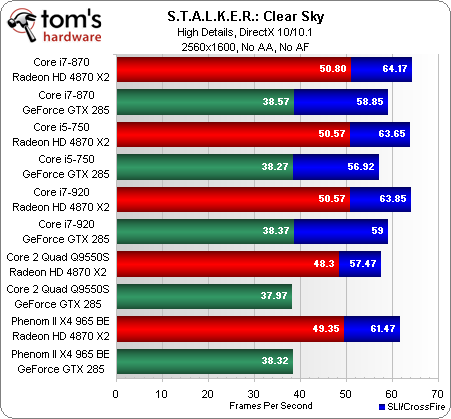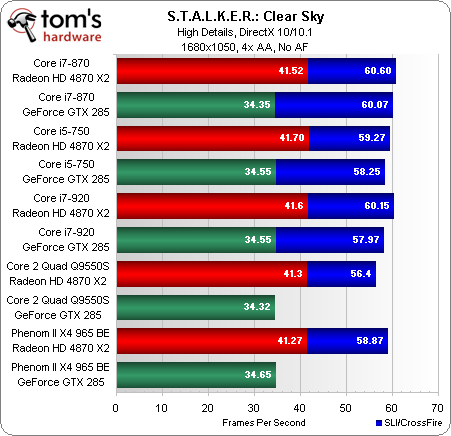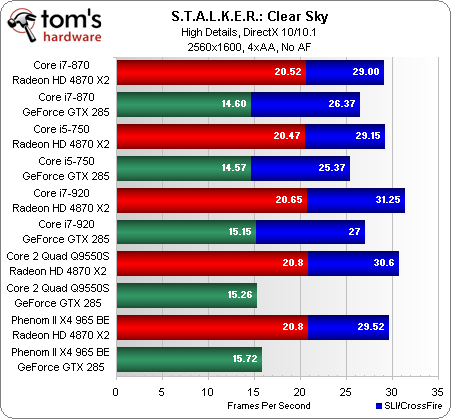Core i5, Core i7, CrossFire, And SLI: Gaming Paradise, Redux?
Benchmark Results: S.T.A.L.K.E.R.: Clear Sky
We’re kicking things off with S.T.A.L.K.E.R., one of the most graphically-challenging benchmarks in our suite (though at 1680x1050, you wouldn’t really know it, since all of our tested platforms achieve playable frame rates, and the addition of a second card doesn’t really do much for our five contenders).
Cranking the resolution up to 2560x1600 does demonstrate a more palpable reason to go for CrossFire or SLI, though.
The real kicker is that, from Core i7 to Core i5 to Phenom II, there’s literally zero difference between these configurations if you’re using a single GeForce GTX 285. One Radeon HD 4870 X2 favors the Nehalem architecture ever so slightly, but the two frames separating the Core 2 Quad from the Core i7-870 are hardly worth making a buying decision on.
What should be popping out at you, however, is how much of a difference CrossFire and SLI support make as we shift into our anti-aliased numbers. To all intents, constructions, and purposes, one ultra-powerful GeForce GTX 285 will turn back the same results in all five of these configurations. The same goes for the Radeon HD 4870 X2 compared down the line. Go for the cheapest motherboard and processor if gaming is your only concern, we say. Put the money saved toward another graphics card.
If that is, in fact, the route you take, note that at 1680x1050, two Radeon HD 4870 X2s and GeForce GTX 285s perform similarly. Only when you step up to 2650x1600 is there a bit of distance put between competing graphics architectures—in this case favoring ATI by a few frames.
As of this writing, a week before the P55 launch, the least-expensive Radeon HD 4870 X2 costs $369 on Newegg. The GeForce GTX 285 OCFU is a $389 board. Given ATI’s advantage in S.T.A.L.K.E.R., the Radeon is looking like a better buy at the high-end. Too bad it seems to be suffering limited availability (actually, that’s a good sign—next-gen, we’re looking forward to you!).
Get Tom's Hardware's best news and in-depth reviews, straight to your inbox.
Current page: Benchmark Results: S.T.A.L.K.E.R.: Clear Sky
Prev Page Test Hardware And Benchmarks Next Page Benchmark Results: Resident Evil 5-
lashton so we can assume for gaming the 965BE (or 955 oc) and ATi cards are just as fast as Core i7 and i5 but at a fraction of the priceReply -
Dekasav Only thing I don't like is how you knock Crossfire with 2 HD 4870X2's, since when is it even feasible that 4-way CF would scale as well as 2-way SLI?Reply
But excellent review, overall, I'm actually surprised at how the 965BE did, I thought it'd be behind, where it was actually right in the pack. -
dirtmountain I would have liked to see a 780a or a 980a SLI motherboard used to check the SLI numbers on the P2 965BE. I'm also surprised there's no overclocking numbers in the comparison, is that article still to come out?Reply -
cangelini It's upcoming dirt; Patrick is the one working on it (and our Italian team sent word of its i5 and i7s in excess of 4.2 GHz)Reply -
anonymous x ReplyLet us know what you think about this in the comments section, but it was pretty clear that Vista was never a favorite, so we're hoping Windows 7 is a more popular environment in which to test
I like vista, rock solid and stable since I got it years ago. Don't listen to the bashers who never have tried the product. -
lashton You giotta remember vista is design for spoecific hardware and powerfull hardware that can run it, so people with P4 3GHz and vista complain about its speed, vista is OK, i dont like it cause my computer doesm't like it thats fine i get over it and chnage my OSReply -
crash27 So there's no benafit from adding a second 285 to a q9550s or an x4 965 be ??Reply
I get a good performance boost from my second gtx280 with my q9650 @ 4 gz




